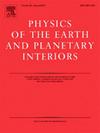Lithospheric structure beneath the Upper Indus Basin and its adjacent regions from inversion of surface wave dispersion
IF 1.9
3区 地球科学
Q2 GEOCHEMISTRY & GEOPHYSICS
引用次数: 0
Abstract
We propose an enhanced model of the crust and upper mantle structure beneath the Upper Indus Basin, derived from the combined inversion of Rayleigh and Love wave group velocity dispersion data from 164 seismic events recorded by 58 stations, covering periods from 4 to 100 s. By using the Genetic Algorithm approach within this joint inversion process, we developed a detailed shear wave velocity model for the region. The earthquakes were categorized into three clusters based on their epicentral locations, allowing for a detailed analysis beneath the western, central, and eastern segments of the Upper Indus Basin. The analysis shows a gradual increase in crustal thickness from the west to the east, with an average thickness of ∼61.8 km and a shear wave velocity ∼ 4.6 km/s. The Lithosphere-Asthenosphere Boundary (LAB) is identified at a depth of 160 km, indicated by a velocity decrease of about 1.6 %. Our results also reveal a sedimentary cover of ∼4 km and we postulate a felsic crust similar to southern Pamir, which could have resulted from the loss of mafic lower crust by lithospheric delamination or foundering due to gravitational instability. We state the absence of mid-crustal low velocity layer within the Basin and also discard the possibility of any requirement for radial anisotropy, based on the adequate fit of Rayleigh and Love the dispersion data with minimal uncertainty. The study provides a significant refinement of the crustal and upper mantle structure of the Upper Indus Basin, contributing valuable insights into regional tectonics.
从面波频散反演研究上印度河盆地及其邻区岩石圈结构
基于58个台站记录的164次地震事件的Rayleigh波群速度频散数据,建立了印度河上游盆地地壳和上地幔结构的增强模型,时间跨度为4 ~ 100 s。在联合反演过程中,利用遗传算法建立了该区域的详细横波速度模型。根据震中位置,这些地震被分为三组,以便对上印度河盆地的西部、中部和东部进行详细分析。分析表明,地壳厚度自西向东逐渐增加,平均厚度为~ 61.8 km,横波速度为~ 4.6 km/s。岩石圈-软流圈边界(LAB)在深度160 km处被确定,速度下降约1.6%。我们的研究结果还揭示了一个约4公里的沉积覆盖层,我们假设了一个类似于帕米尔高原南部的长英质地壳,这可能是由于岩石圈分层或重力不稳定引起的下沉造成的基性下地壳的损失。基于Rayleigh和Love色散数据的充分拟合,我们认为盆地内不存在中地壳低速层,也放弃了对径向各向异性的任何要求的可能性。该研究为上印度河盆地的地壳和上地幔结构提供了重要的细化,为区域构造提供了有价值的见解。
本文章由计算机程序翻译,如有差异,请以英文原文为准。
求助全文
约1分钟内获得全文
求助全文
来源期刊

Physics of the Earth and Planetary Interiors
地学天文-地球化学与地球物理
CiteScore
5.00
自引率
4.30%
发文量
78
审稿时长
18.5 weeks
期刊介绍:
Launched in 1968 to fill the need for an international journal in the field of planetary physics, geodesy and geophysics, Physics of the Earth and Planetary Interiors has now grown to become important reading matter for all geophysicists. It is the only journal to be entirely devoted to the physical and chemical processes of planetary interiors.
Original research papers, review articles, short communications and book reviews are all published on a regular basis; and from time to time special issues of the journal are devoted to the publication of the proceedings of symposia and congresses which the editors feel will be of particular interest to the reader.
 求助内容:
求助内容: 应助结果提醒方式:
应助结果提醒方式:


